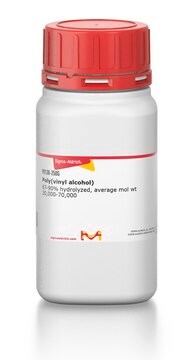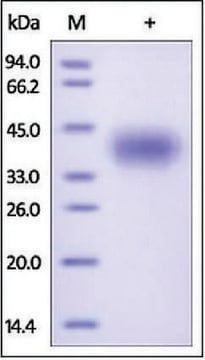M6145
1-Thioglycérol
liquid, BioReagent, suitable for cell culture, ≥97% (titration)
Synonyme(s) :
α-Monothioglycérol, α-Thioglycérol, 3-Mercapto-1,2-propanediol
About This Item
Produits recommandés
Source biologique
synthetic (organic)
Gamme de produits
BioReagent
Pureté
≥97% (titration)
Forme
liquid
Technique(s)
cell culture | mammalian: suitable
single cell analysis: suitable
Indice de réfraction
n20/D 1.527 (lit.)
Point d'ébullition
118 °C/5 mmHg (lit.)
Solubilité
water: miscible 0.1 M
Densité
1.25 g/mL at 25 °C (lit.)
Température de stockage
2-8°C
Chaîne SMILES
OCC(O)CS
InChI
1S/C3H8O2S/c4-1-3(5)2-6/h3-6H,1-2H2
Clé InChI
PJUIMOJAAPLTRJ-UHFFFAOYSA-N
Vous recherchez des produits similaires ? Visite Guide de comparaison des produits
Application
Produit(s) apparenté(s)
Mention d'avertissement
Danger
Mentions de danger
Conseils de prudence
Classification des risques
Acute Tox. 3 Dermal - Acute Tox. 3 Inhalation - Acute Tox. 4 Oral - Skin Irrit. 2 - Skin Sens. 1B
Code de la classe de stockage
6.1C - Combustible acute toxic Cat.3 / toxic compounds or compounds which causing chronic effects
Classe de danger pour l'eau (WGK)
WGK 3
Point d'éclair (°F)
210.2 °F - closed cup
Point d'éclair (°C)
99 °C - closed cup
Équipement de protection individuelle
Eyeshields, Faceshields, Gloves, type ABEK (EN14387) respirator filter
Certificats d'analyse (COA)
Recherchez un Certificats d'analyse (COA) en saisissant le numéro de lot du produit. Les numéros de lot figurent sur l'étiquette du produit après les mots "Lot" ou "Batch".
Déjà en possession de ce produit ?
Retrouvez la documentation relative aux produits que vous avez récemment achetés dans la Bibliothèque de documents.
Les clients ont également consulté
Notre équipe de scientifiques dispose d'une expérience dans tous les secteurs de la recherche, notamment en sciences de la vie, science des matériaux, synthèse chimique, chromatographie, analyse et dans de nombreux autres domaines..
Contacter notre Service technique











